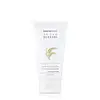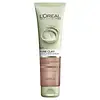What's inside
What's inside
 Key Ingredients
Key Ingredients

 Benefits
Benefits

 Concerns
Concerns

 Ingredients Side-by-side
Ingredients Side-by-side

Water
Skin ConditioningKaolin
AbrasiveSodium Cocoyl Glycinate
CleansingOryza Sativa Extract
AbsorbentGlycerin
HumectantBentonite
AbsorbentMyristic Acid
CleansingPotassium Hydroxide
BufferingLauric Acid
CleansingGlycol Distearate
EmollientTitanium Dioxide
Cosmetic ColorantCentella Asiatica Extract
CleansingFicus Carica Fruit Extract
HumectantAvena Sativa Kernel Extract
AbrasiveAcmella Oleracea Extract
Skin ProtectingCoix Lacryma-Jobi Ma-Yuen Seed Extract
Skin ConditioningCoix Lacryma-Jobi Ma-Yuen Shell Extract
HumectantUlmus Davidiana Root Extract
Skin ConditioningAmaranthus Caudatus Seed Extract
Skin ConditioningChenopodium Quinoa Seed Extract
Skin ConditioningOlea Europaea Fruit Oil
MaskingCoix Lacryma-Jobi Ma-Yuen Seed Water
Skin ConditioningCitrus Aurantium Dulcis Flower Oil
AstringentHydrogenated Lecithin
EmulsifyingMagnesium Aluminum Silicate
AbsorbentPalmitic Acid
EmollientStearic Acid
CleansingButylene Glycol
HumectantDisodium EDTA
Decylene Glycol
Skin ConditioningTorreya Nucifera Seed Oil
EmollientCeramide NP
Skin ConditioningHydroxyacetophenone
AntioxidantEthylhexylglycerin
Skin ConditioningWater, Kaolin, Sodium Cocoyl Glycinate, Oryza Sativa Extract, Glycerin, Bentonite, Myristic Acid, Potassium Hydroxide, Lauric Acid, Glycol Distearate, Titanium Dioxide, Centella Asiatica Extract, Ficus Carica Fruit Extract, Avena Sativa Kernel Extract, Acmella Oleracea Extract, Coix Lacryma-Jobi Ma-Yuen Seed Extract, Coix Lacryma-Jobi Ma-Yuen Shell Extract, Ulmus Davidiana Root Extract, Amaranthus Caudatus Seed Extract, Chenopodium Quinoa Seed Extract, Olea Europaea Fruit Oil, Coix Lacryma-Jobi Ma-Yuen Seed Water, Citrus Aurantium Dulcis Flower Oil, Hydrogenated Lecithin, Magnesium Aluminum Silicate, Palmitic Acid, Stearic Acid, Butylene Glycol, Disodium EDTA, Decylene Glycol, Torreya Nucifera Seed Oil, Ceramide NP, Hydroxyacetophenone, Ethylhexylglycerin
Water
Skin ConditioningKaolin
AbrasiveGlycerin
HumectantButylene Glycol
HumectantZea Mays Starch
AbsorbentDecyl Glucoside
CleansingSodium Laureth Sulfate
CleansingPEG-7 Glyceryl Cocoate
EmulsifyingEucalyptus Globulus Leaf Extract
PerfumingZinc Gluconate
Skin ConditioningMoroccan Lava Clay
AbrasiveCarrageenan
Tetrasodium EDTA
Xanthan Gum
EmulsifyingMontmorillonite
AbsorbentSalicylic Acid
MaskingPhenoxyethanol
PreservativeCI 61570
Cosmetic ColorantCI 77492
Cosmetic ColorantLinalool
PerfumingGeraniol
PerfumingCoumarin
PerfumingCitronellol
PerfumingParfum
MaskingWater, Kaolin, Glycerin, Butylene Glycol, Zea Mays Starch, Decyl Glucoside, Sodium Laureth Sulfate, PEG-7 Glyceryl Cocoate, Eucalyptus Globulus Leaf Extract, Zinc Gluconate, Moroccan Lava Clay, Carrageenan, Tetrasodium EDTA, Xanthan Gum, Montmorillonite, Salicylic Acid, Phenoxyethanol, CI 61570, CI 77492, Linalool, Geraniol, Coumarin, Citronellol, Parfum
 Reviews
Reviews

Ingredients Explained
These ingredients are found in both products.
Ingredients higher up in an ingredient list are typically present in a larger amount.
Butylene Glycol (or BG) is used within cosmetic products for a few different reasons:
Overall, Butylene Glycol is a safe and well-rounded ingredient that works well with other ingredients.
Though this ingredient works well with most skin types, some people with sensitive skin may experience a reaction such as allergic rashes, closed comedones, or itchiness.
Learn more about Butylene GlycolGlycerin is already naturally found in your skin. It helps moisturize and protect your skin.
A study from 2016 found glycerin to be more effective as a humectant than AHAs and hyaluronic acid.
As a humectant, it helps the skin stay hydrated by pulling moisture to your skin. The low molecular weight of glycerin allows it to pull moisture into the deeper layers of your skin.
Hydrated skin improves your skin barrier; Your skin barrier helps protect against irritants and bacteria.
Glycerin has also been found to have antimicrobial and antiviral properties. Due to these properties, glycerin is often used in wound and burn treatments.
In cosmetics, glycerin is usually derived from plants such as soybean or palm. However, it can also be sourced from animals, such as tallow or animal fat.
This ingredient is organic, colorless, odorless, and non-toxic.
Glycerin is the name for this ingredient in American English. British English uses Glycerol/Glycerine.
Learn more about GlycerinKaolin is a clay. It is used for oil control and to help minimize pores. Like other clays, kaolin has the ability to absorb excess sebum or oil. This can help clean out pores and mattify the skin.
Some types of kaolin may have exfoliating properties. When water is added to kaolin, it becomes a paste with small abrasive particles.
Most kaolin is a white color, but may be pink/orange/red depending on where it comes from.
The name 'kaolin' comes from a Chinese village named 'Gaoling'. Kaolin clay comes from rocks rich in kaolinite. Kaolinite, the mineral, has a silicate layered structure. Kaolinite is formed from chemical weathering of aluminum siilicate minerals.
Besides skincare, kaolin is commonly used to make glossy paper, in ceramics, toothpaste, and as medicine to soothe stomach issues.
Learn more about KaolinWater. It's the most common cosmetic ingredient of all. You'll usually see it at the top of ingredient lists, meaning that it makes up the largest part of the product.
So why is it so popular? Water most often acts as a solvent - this means that it helps dissolve other ingredients into the formulation.
You'll also recognize water as that liquid we all need to stay alive. If you see this, drink a glass of water. Stay hydrated!
Learn more about Water